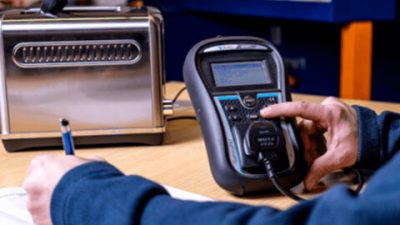The New Electrical Equipment Testing Codes of Practices
Months of anticipation and speculation has come to an end with the 5th Edition of the IET Code of Practice for In-Service Inspection and Testing of Electrical Equipment being officially released. To meet the requirements of the new 5th Edition, City & Guilds have released their 2377-77 course, replacing the old 2377-22, which will be fully applicable from the 28th February 2021.
In response to this, we have developed two independent courses that have been designed for people with different levels of expertise that will be available from February 2021.
Entry Level In-Service Inspection and Testing of Electrical Equipment (PAT Testing) | City & Guild 2377-77 - £615 (3 Day Course) - This course is designed specifically for those with little or no electrical experience. The course content is identical to the 2-day testing course, but with the extra day to provide greater detail in electrical principles, safe isolation and safe systems of work - View Course
Experienced In-Service Inspection and Testing of Electrical Equipment (PAT Testing) | City & Guild 2377-77 - £475 (2 Day Course) - This course is intended for those with an established electrical background and a basic understanding of testing. The course covers both management and the practical aspects of testing and is ideal for those looking to offer EET / PAT testing as a service - View Course
Call us on 0333 121 1215 or email info@ppltraining.co.uk if you have any questions or would like to make a future booking.
Changes to the Code Of Practice
Within the new IET 5th Edition Code of Practice for the In-Service Inspection and Testing of Electrical Equipment comes a range of changes, with a notable departure from periodical inspection and replaced with a more risk assessment led structure. The context of equipment use is also a major focus, emphasising not just the importance of the environment the equipment will be used in, but also the users’ skill.
Importantly though, the 5th Edition of the Code of Practice is trying to distance itself from the Portable Appliance Testing name and instead trying to rebrand to include all electrical equipment both portable and in-situ. The term Portable Appliance Testing (PAT) has since been removed entirely from the documentation, other than the explanatory preface.
Another addition within the 5th Edition are the definitions for those carrying out the electrical checks.
User – the person using the equipment who should carry out simple checks for defects
Inspector – an operative who will carry out a formal visual inspection of the equipment and record the results
Tester – an operative who is competent to inspect and test electrical equipment and formally report on its condition for safe continued use.
Levels of Experience & Training
In reference to HSG107 - Maintaining portable electrical equipment, people with the responsibility of electrical equipment testing should be appropriately trained and is the responsibility of the employer to ensure they have adequate training for the work being carried out. This results in two levels of competency,
Level 1:
A person not skilled in electrical work routinely uses a simple ‘pass/fail’ type of portable appliance tester where no interpretation of readings is necessary. The person would need to know how to use the test equipment correctly. Providing the appropriate test procedures are rigorously followed and acceptance criteria are clearly defined, this routine can be straightforward.
People who have a Level 1 competency, will typically conduct work on electrical equipment where no disassembly is required and are able to conduct a visual inspection.
Alternatively,
Level 2:
A person with appropriate electrical skills uses a more sophisticated instrument that gives readings requiring interpretation. Such a person would need to be competent through technical knowledge or experience related to this type of work
People with a level 2 competency must have had adequate training for the inspections and testings they will be carrying out. An understanding of electrical principles, safe isolation procedures, safe systems of work is essential.
For those wanting to carry out electrical testing, we have designed two courses for people of different expertise.
Entry Level In-Service Inspection and Testing of Electrical Equipment (PAT Testing) | City & Guild 2377-77 - £615 (3 Day Course) - We have specifically designed a course for those with little or no electrical experience. The course content is identical to the two-day testing course, but with the extra day to provide greater detail in electrical principles, safe isolation and safe systems of work
- View Course
Experienced In-Service Inspection and Testing of Electrical Equipment (PAT Testing) | City & Guild 2377-77 - £475 (2 Day Course) - For those who have an established electrical background and a basic understanding of testing we have developed a course that covers both management and the practical aspects of testing and is ideal for those looking to offer electrical equipment testing/portable appliance testing as a service. - View Course
These courses will be available from February 2021 and aims to provide the delegate with the essential knowledge required to carry out the tests and inspections required of them.
Contact Us
Call us on 0333 121 1215 or email info@ppltraining.co.uk if you have any questions or would like to make a future booking.
